Articles
- Page Path
- HOME > Korean J Community Nutr > Volume 17(5); 2012 > Article
-
Original Article
- Diet-related Behaviors, Perception and Food Preferences of Multicultural Families with Vietnamese Wives
- Jisun So, Sung Nim Han
-
Korean Journal of Community Nutrition 2012;17(5):589-602.
DOI: https://doi.org/10.5720/kjcn.2012.17.5.589
Published online: October 31, 2012
Department of Food and Nutrition, College of Human Ecology, Seoul National University, Seoul, Korea.
Multicultural Human Ecology Center, Research Institute of Human Ecology, College of Human Ecology, Seoul National University, Seoul, Korea.
- Corresponding author: Sung Nim Han, Department of Food and Nutrition, College of Human Ecology, Seoul National University, Seoul 151-742, Korea. Tel: (02) 880-6836, Fax: (02) 884-0305, snhan@snu.ac.kr
Copyright © 2012 The Korean Society of Community Nutrition
- 483 Views
- 0 Download
- 15 Crossref
Abstract
- The Korean society has gone through a dramatic change in its population, with rapidly increasing number of multicultural families through international marriages since 1990s. This study investigated the differences between multicultural families and Korean families in three areas related to dietary behaviors: diet-related behaviors and perception, and food preferences. A cross-sectional analysis was performed in 500 Koreans from Korean families and 104 couples from the multicultural families with Vietnamese wives. More subjects from multicultural families grew up in the countryside, received less education and also had lower income than the subjects from Korean families. Multicultural families ate traditional Korean meals more often at home and dined out less often than Korean families. The multicultural families focused more attention on nutritional aspects of their diets than Korean families. The Vietnamese wives in multicultural families favored Vietnamese foods but they rarely ate those foods in Korea despite an easy accessibility to Vietnamese ingredients. In conclusion, the multicultural families had more traditional Korean dietary patterns than Korean families, which could have been influenced by their socioeconomic factors. Further research with a quantitative analysis is needed in future studies to understand the effect of dietary patterns on nutritional status and quality of life in multicultural and Korean families.
-
This work was supported by the Multicultural Human Ecology Center at the Research Institute of Human Ecology, Seoul National University.
NOTES
- 1. Cho YA. A study on evaluation of food behavior and nutritional risks of Vietnamese female immigrants in Korea. 2010; Kyung Hee University; 50-53 Dissertation.
- 2. Choi JH, Lee GI. The study on the changes and prospects of food consumption pattern. 1995; Seoul: Korea Rural Economic Institute; 19-39.
- 3. Chung ES. The effect of demographic characteristics on food expenditure pattern of urban household. Nonghyup Monthly Report. 2004; 557: 1-18.
- 4. Hanh TTM, Komatsu T, Hung NT, Chuyen VN, Yoshimura Y, Tien PG, Yamamoto S. Nutritional status of middle-aged Vietnamese in Ho Chi Minh city. J Am Coll Nutr. 2001; 20(6): 616-622.ArticlePubMed
- 5. He J, Klag MJ, Wu Z. Effect of immigration and related environmental changes on serum lipid levels in southwestern Chinese men. Am J Epidemiol. 1996; 144(9): 839-849.PubMed
- 6. Iso H, Aaron RF, Kenneth K. Hemostatic variables in Japanese and Causian men. Plasma fibrinogen, factor VIIc, factor VIIIc, and von Willebrand factor and their relations to cardiovascular disease risk factors. Am J Epidemiol. 1989; 130(5): 925-934.PubMed
- 7. Huang B, Rodriguez BL, Burchfiel CM, Chyou PH, Curb JD, Yano K. Acculturation and prevalence of diabetes among Japanese-American men in Hawaii. Am J Epidemiol. 1996; 144(7): 674-681.ArticlePubMed
- 8. Hwang JY, Lee SE, Kim SH, Chung HW, Kim WY. Psychological distress is associated with inadequate dietary intake in Vietnamese marriage immigrant women in Korea. J Am Diet Assoc. 2010; 110(5): 779-785.ArticlePubMed
- 9. Kim BR. The status of international marriage immigration and adaptation to Korean society of immigrants. 2008; Sogang University; 34-35 Dissertation.
- 10. Kim JM, Lee NH. Analysis of the dietary life of immigrant women from multicultural families in the Daegu area. J Korean Diet Assoc. 2009; 15(4): 405-418.
- 11. Kim KH. Effect of a food-related lifestyle on the consumption and satisfaction with Korean foods, and intention to revisit. J Korea Contents Assoc. 2010; 10(8): 370-380.
- 12. Kim MS. Food away from home expenditure of the urban household : Effect of wive's employment. 1998; Seoul National University; 10-18 Dissertation.
- 13. Kim SH, Kim WY, Lyu JE, Chung HW, Hwang JY. Dietary intakes and eating behaviors of Vietnamese female immigrants to Korea through marriage and Korean spouses and correlations of their diets. Korean J Community Nutr. 2009; 14(1): 22-30.
- 14. Korea Immigration Service. The statistics of marriage immigrants. 2011; cited 2012 April 14. Available from http://www.immigration.go.kr.
- 15. Korean Educational Development Institute. Korean Education at a Glance (KEAG). 2008; cited 2012 September 21. Available from http://cesi.kedi.re.kr.
- 16. Lyu JE. Dietary characteristics of Vietnamese female marriage immigrants in Korea. 2008; Ewha Womens University; 51-61 Dissertation.
- 17. Lyu JE, Yang YJ, Lee SE, Chung HW, Kim MK, Kim WY. Nutritional status of Vietnamese female marriage immigrants to Korea in relation to length of residence in Korea. Ann Nutr Metab. 2009; 55: 317-324.ArticlePubMedPDF
- 18. Ministry of Health & Welfare and Family Affairs. National survey on multicultural families. 2009; cited 2012 September 21. Available from http://www.mw.go.kr.
- 19. Park HR, Lee KY, Ryu JS. Analysis of food consumption patterns by income levels using annual report on the family income and expenditure survey. Korean J Community Nutr. 1997; 2(4): 633-646.
- 20. Parrish JB. Implication of changing food habits for nutrition educators. J Nutr Educ. 1971; 2(4): 140-146.
- 21. Raberg Kjollesdal MK, Holmboe-Ottesen G, Wandel M. Associations between food patterns, socioeconomic position and working situation among adult, working women and men in Oslo. Eur J Clin Nutr. 2010; 64(10): 1150-1157.ArticlePubMedPDF
- 22. Statistics Korea. Household income & expenditure trends in the first quarter 2011. 2011; cited 2012 September 21. Available from http://kostat.go.kr.
- 23. Turrell G, Kavanagh AM. Socio-economic pathways to diet: modelling the association between socio-economic position and food purchasing behavior. Public Health Nutr. 2006; 9(3): 375-383.PubMed
- 24. Yang EJ, Chung HK, Kim WY, Bianchi L, Song WO. Chronic diseases and dietary changes in relation to Korean American's length of residence in the United States. J Am Diet Assoc. 2007; 107(6): 942-950.PubMed
- 25. Yang W, Read M. Dietary pattern changes of Asian immigrants. Nutr Res. 1996; 16(8): 1277-1293.
REFERENCES
Figure & Data
REFERENCES
Citations

- Analysis of eating behavior of Indonesian women from multicultural and non-multicultural families
Ulya Ardina, Su-In Yoon, Jin Ah Cho
Journal of Nutrition and Health.2024; 57(2): 228. CrossRef - The Food Delivery App Information Design Suggestion for Foreigners in
South Korea
Diana Iziiatullina, Jinyeon Shin, Aygul Akhmetova, Soojin Park
Journal of Multimedia Information System.2022; 9(4): 327. CrossRef - Development and evaluation of semi-quantitative food frequency questionnaire for marriage migrant women in multicultural families
Jung-Hyun Kim, Oh Yoen Kim, Min June Lee, Eunju Park
Journal of Nutrition and Health.2021; 54(1): 76. CrossRef - Comparison of Needs for Pregnancy and Postpartum Adaptation of Chinese Immigrant Women and Vietnamese Immigrant Women in South Korea
Geum Hee Jeong, Kyung Won Kim, Sunghee Baik
Korean Journal of Women Health Nursing.2019; 25(1): 19. CrossRef - Study on the change and acculturation of dietary pattern of Southeast Asian workers living in South Korea
Eun Jung Lee, Kyung-Ran Lee, Seung-Joo Lee
Appetite.2017; 117: 203. CrossRef - A Comparative Analysis of the Relationship between Food Neophobia Scale and Korean Food Perception of Southeast Asian Workers Living in South Korea
Kyung-Ran Lee, Eun Jung Lee
Journal of The Korean Society of Food Culture.2016; 31(2): 131. CrossRef - Dietary behaviors of female marriage immigrants residing in Gwangju, Korea
Eun Ju Yang
Journal of Nutrition and Health.2016; 49(3): 179. CrossRef - Dietary Behavior of Marriage Migrant Women according to Their Nationality in Multicultural Families
Jung-Hyun Kim, Myung-Hee Lee
Korean Journal of Community Nutrition.2016; 21(1): 53. CrossRef - Analysis of Sensory Properties for Chicken Meat Products in Multicultural Families
Gye-Woong Kim, Hack-Youn Km
Korean Journal of Poultry Science.2016; 43(3): 129. CrossRef - Food intake and nutritional status of female marriage immigrants residing in Gwangju, Korea
Eun Ju Yang, Jin Mo Khil
Journal of Nutrition and Health.2016; 49(5): 358. CrossRef - Comparison of Eating Habits and Food Preference of Elementary School Children between Multi-cultural Families and Ordinary Families in Gyeongnam Province
Joo Hee Lee, Seon Ok Jeong, Changim Kim
The Korean Journal of Food And Nutrition.2015; 28(6): 973. CrossRef - Comparative Study on Dietary Life of Southeast Asian Workers Living in South Korea
Eun Jung Lee, Kyung-Ran Lee
Journal of The Korean Society of Food Culture.2015; 30(4): 422. CrossRef - Factors related to Korean Dietary Adaptation in Chinese Female Marriage Immigrants living in the Seoul Metropolitan Area
Kana Asano, Jihyun Yoon, Si-Hyun Ryu
Journal of the East Asian Society of Dietary Life.2015; 25(2): 234. CrossRef - Japanese Female Marriage Immigrants' Dietary Life and Health-related Characteristics by Level of Dietary Adaptation after Immigration to Korea
kana Asano, Jihyun Yoon, Si-Hyun Ryu
Journal of the East Asian Society of Dietary Life.2015; 25(5): 765. CrossRef - Chinese Female Marriage Immigrants' Dietary Life after Immigration to Korea : Comparison between Han-Chinese and Korean-Chinese
Kana Asano, Jihyun Yoon, Si-Hyun Ryu
Korean Journal of Community Nutrition.2014; 19(4): 317. CrossRef
Questionnaire
General characteristics of Koreans and multicultural families1)
1) Values are % (number) except height, weight, and BMI which are Mean ± SD
*: p < 0.05, **: p < 0.01, ***: p < 0.001
Diet & health-related behaviors (males)1)
1) Values are % (number)
*: p < 0.05, **: p < 0.01, ***: p < 0.001
Diet & health-related behaviors (females)1)
1) Values are % (number)
*: p < 0.05, **: p < 0.01, ***: p < 0.001
Diet-related perceptions (males)1)
1) Values are % (number)
*: p < 0.05, **: p < 0.01, ***: p < 0.001
Diet-related perceptions (females)1)
1) Values are % (number)
*: p < 0.05, **: p < 0.01, ***: p < 0.001
Food preferences (5 multiple responses)1)
1) Values are % (number)
Frequency of Vietnamese food consumption1)
1) % (number)
1) Values are % (number) except height, weight, and BMI which are Mean ± SD *: p < 0.05, **: p < 0.01, ***: p < 0.001
1) Values are % (number) *: p < 0.05, **: p < 0.01, ***: p < 0.001
1) Values are % (number) *: p < 0.05, **: p < 0.01, ***: p < 0.001
1) Values are % (number) *: p < 0.05, **: p < 0.01, ***: p < 0.001
1) Values are % (number) *: p < 0.05, **: p < 0.01, ***: p < 0.001
1) Values are % (number)
1) % (number)

 KSCN
KSCN
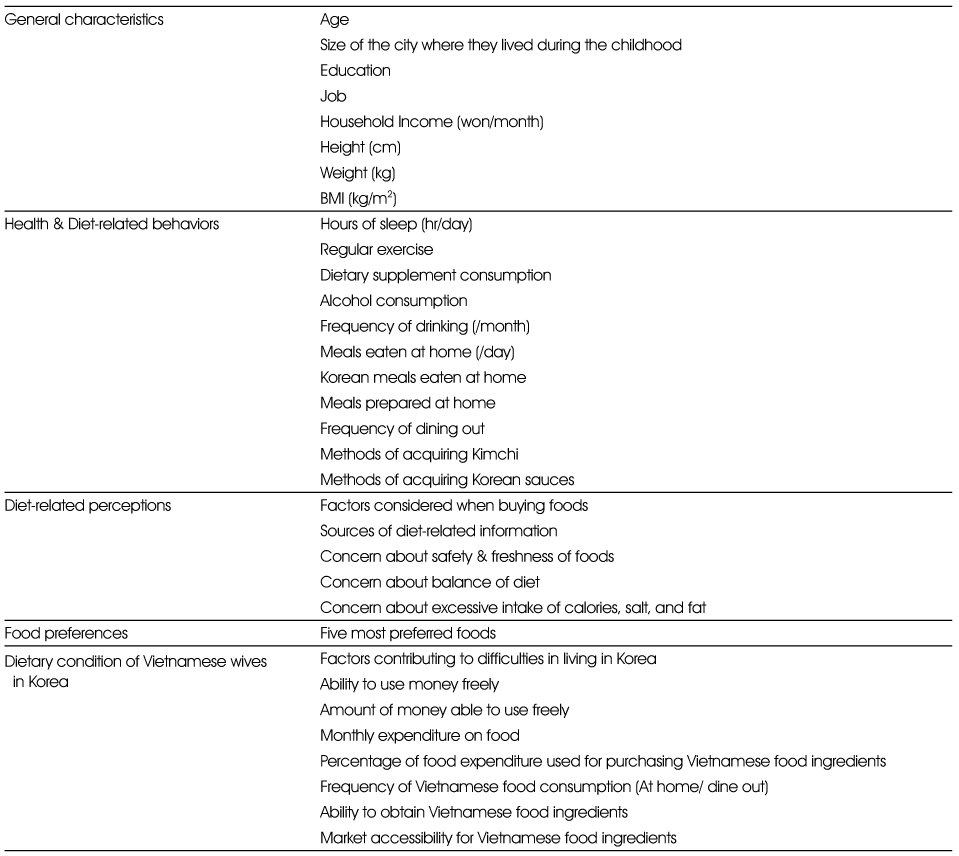
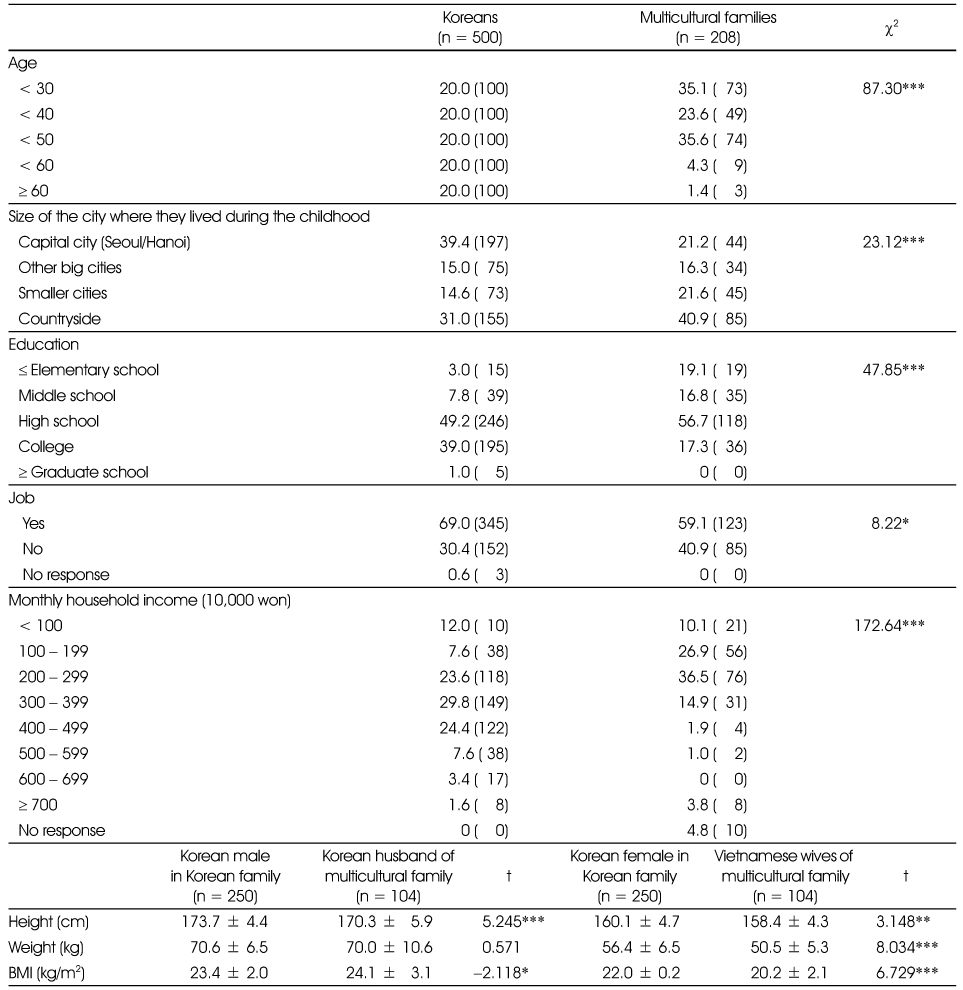
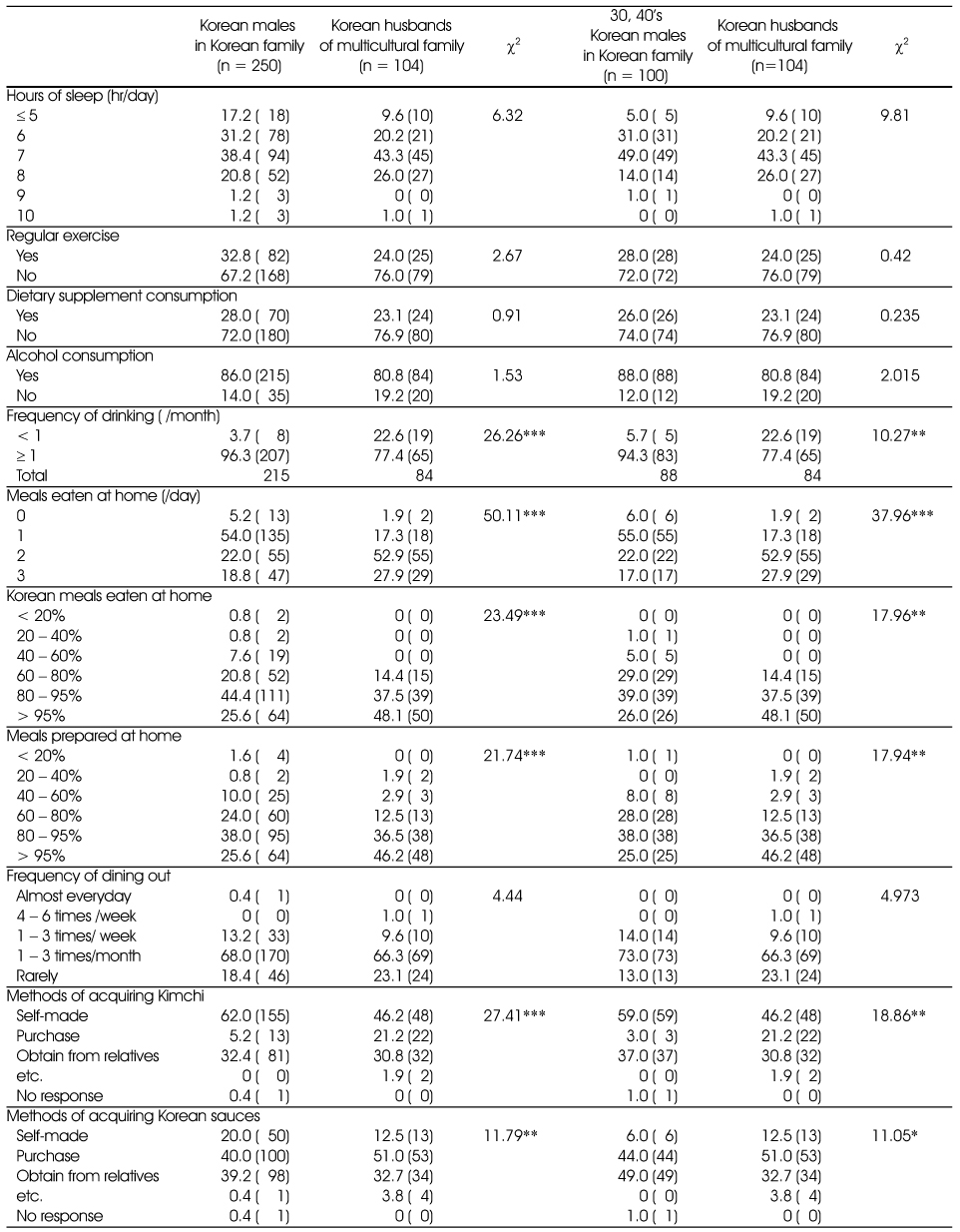
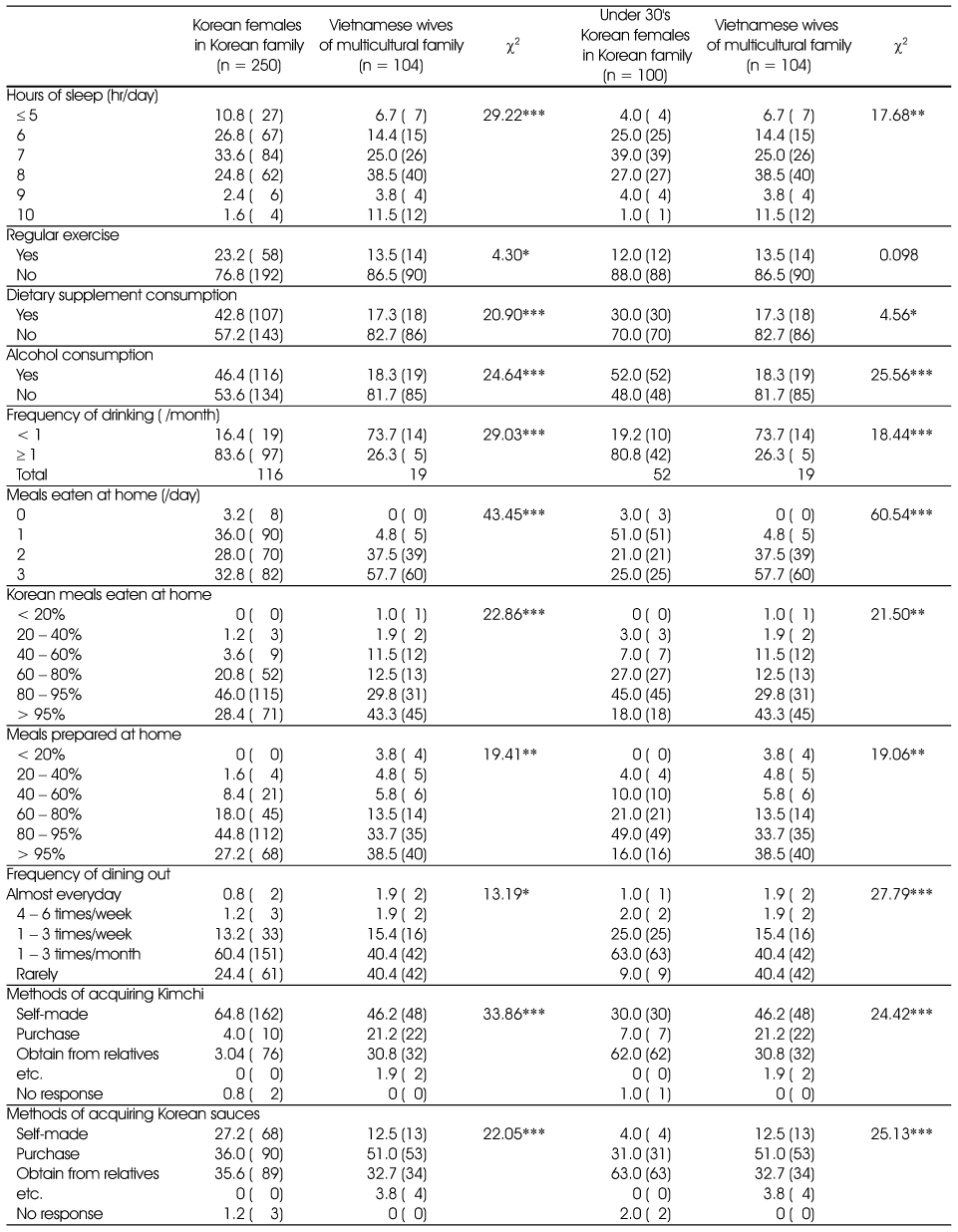
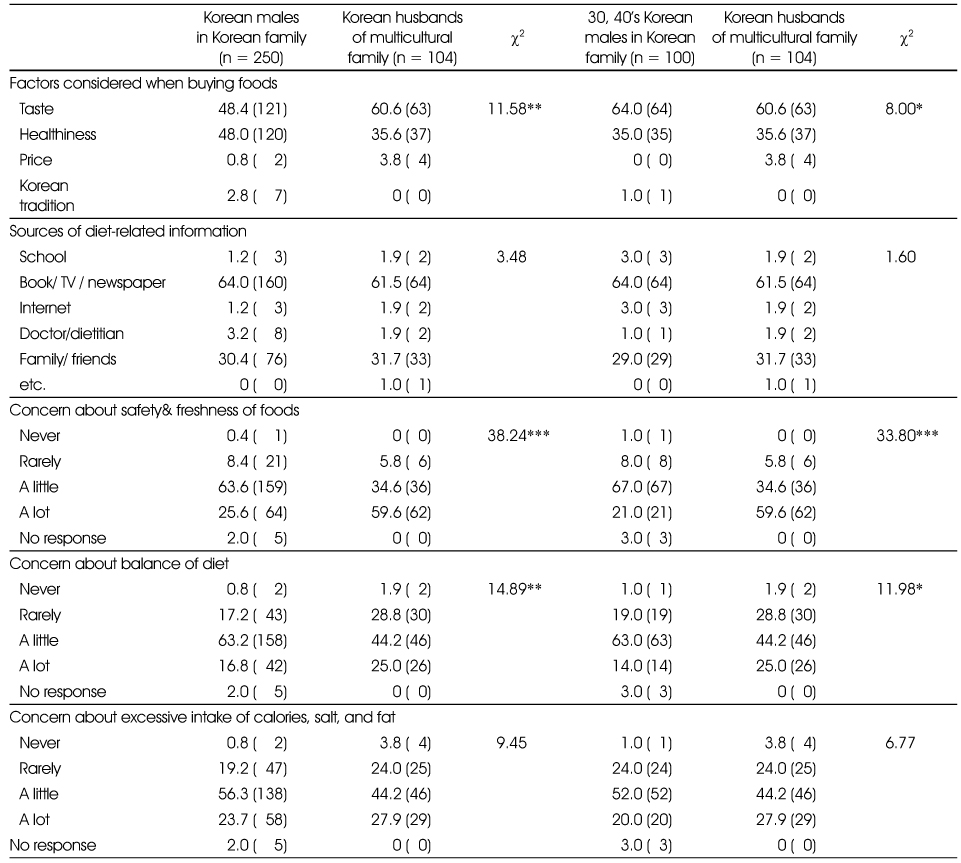
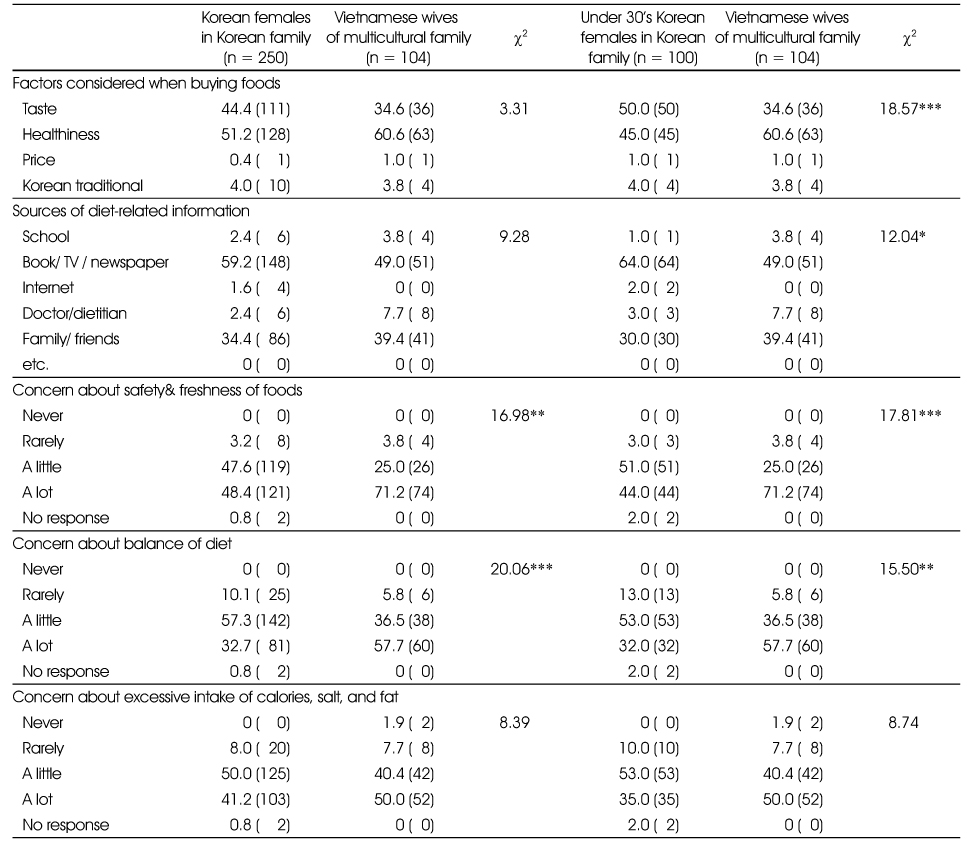
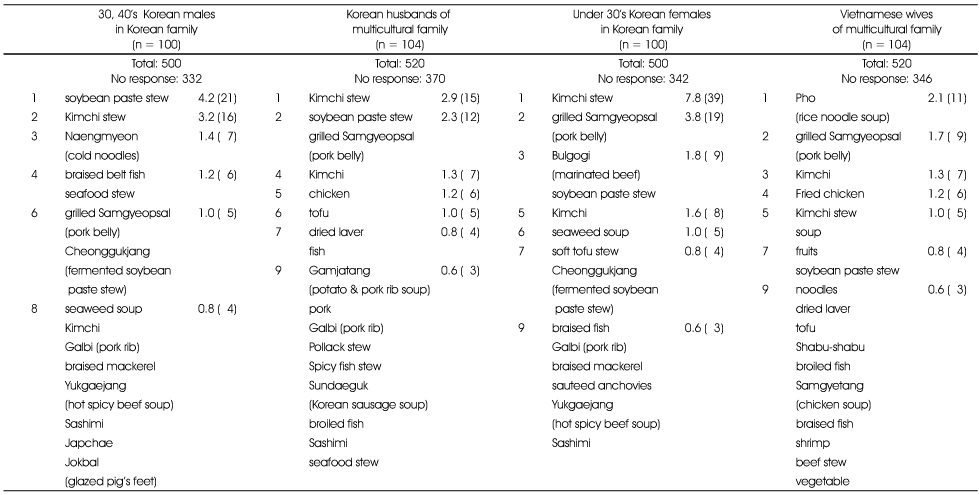
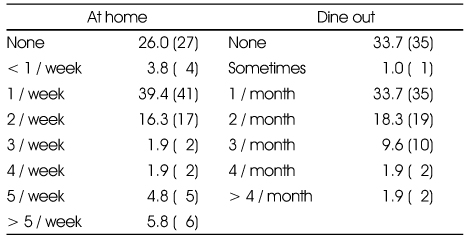
 PubReader
PubReader Cite
Cite


